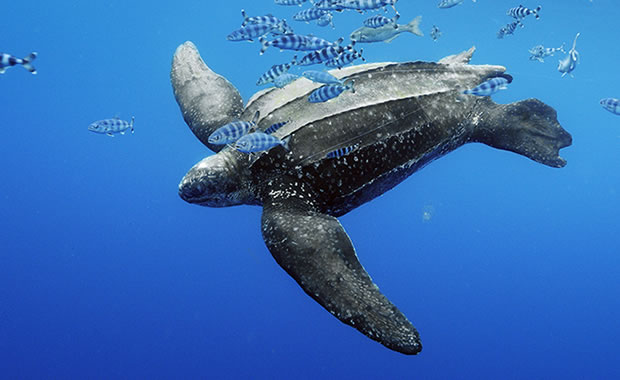
Finback Whale
Francois Sarano |
Creature Profile
The finback whale (or fin whale) is the second largest whale on earth after the blue whale, reaching up to 70 feet in length (about the
size of 13 adults laid head to feet) and weighing up to 70 tons.
These whales have a slender build and are the fastest whales on earth, traveling up to 35 mph. They are
brownish gray in color above and white below. They have pointed snouts, paired blowholes, and a white patch
on the right side of the lower jaw. The left side of the jaw is gray or black. The dorsal fin is strongly curved and is about 23.6
inches high. Finbacks can dive as low as 820 feet in the waters and can stay below for 10 to 15 minutes. They have also been known to leap completely out of the water.
Finback whales are found in all the world's major oceans. They may migrate to subtropical waters for mating and calving during the winter months and to colder areas of the Arctic and Antarctic to feed during the summer months. They are often alone, but groups of three to seven whales have been observed, and up to 300 whales have been observed migrating across the ocean together. Diet consists mainly of krill (small shrimp-like fish), and they also eat other crustaceans, squid and schooling fish. These whales consume up to three tons of fish a day. Their reproductive habits are largely unknown, but it is believed that mating and calving occur from November to March in warm waters. Females generally give birth to one young but have been found impregnated with up to six young. The gestation period is 11 to 12 months.
The latest population estimate for the finback whale is 75,000 to 100,000 whales. As
Wikipedia Article

|
Wikipedia Article Copyright Notice: This article is licensed under the GNU Free Documentation License. It uses material from the Wikipedia article "Fin whale". |
More Links about the Finback Whale:
Reference Links:Finback Whale - Wikipedia
Conservation Links:
American Cetacean Society
May 11, 2017
Glenn, C. R. 2006. "Earth's Endangered Creatures - Finback Whale Facts" (Online). Accessed 7/26/2024 at http://earthsendangered.com/profile.asp?sp=929&ID=2.
Need more Finback Whale facts?




